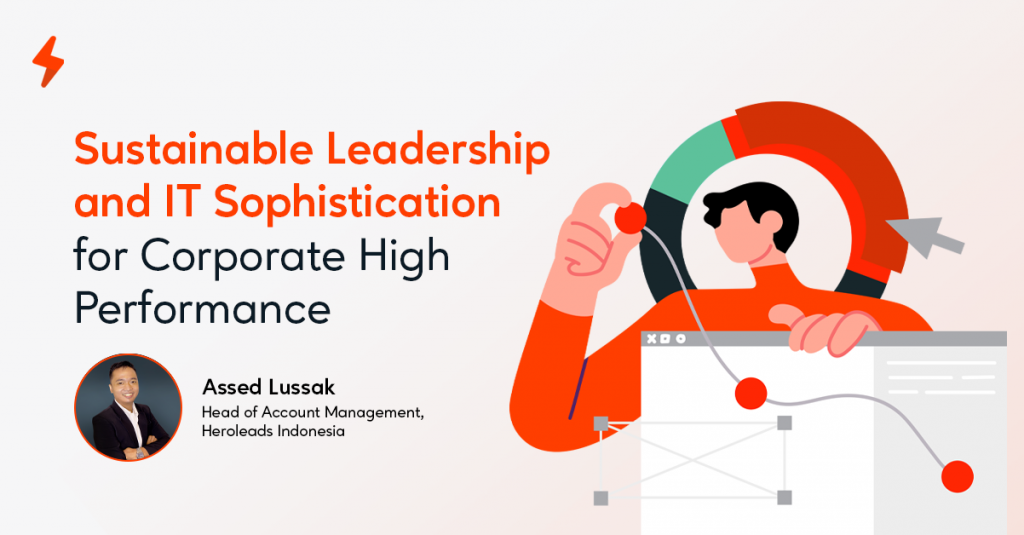Sustainable Leadership and IT Sophistication for Corporate High Performance

Suriyankietkaew & Avery (2016) emphasized how organizations are operating in ever more complexity, largely due to rapid changes surrounding their business environments (e.g., globalization, increasingly scarce resources, social media, advanced multimedia, and high technologies). Financial scandals, bankruptcies, disasters, and external pressure from various publics, governments, and NGOs continue to force companies to take account of increasing complexity in their business operations to achieve sustainability in the sense of resilience and longevity (Smith & Sharicz, 2011).
In the leadership field, sustainability has been debated among organizational leadership and management scholars. One view is that leadership is critical for creating organizational resilience, longevity, and sustainability in firms (Dobson, 1996). Varra & Timolo (2017) proposes that an enterprise needs to adopt a range of management practices to generate a proper balance between economic, social, and ecological objectives while attaining high performance, resilience, and sustainability. However, which leadership and management practices help ensure the sustainability of an enterprise? Obviously, to be sustainable, companies need to take care of their financial performance (Varra & Timolo, 2017).
It cannot be then denied that the world is rapidly shifting from analog to digital. People are consuming more and more digital content daily and companies that have not yet recognized this in their marketing strategies need to adapt fast. In the marketing world, smart marketers keep on top of the scale of change and ensure their marketing strategies and their touchpoint mirrors where the consumer is spending their time (Singh, 2008). For other practices, Mankiw, Romer, & Weil (1992) argue that the context of the firm is important for converting IT investments into productive outputs: he found a positive relationship between IT investment and firm performance in the manufacturing sector. His findings revealed that heavy use of transactional IT investment was significantly and consistently associated with strong firm performance.
In the context of Indonesian medium enterprises, which play a significant role in Indonesia by having a high contribution to employment growth (Nugroho, 2015), this group of enterprises can have a positive growth to be able to bring greater impact to the economy.
Sustainable Leadership to Lead an Organization
Sustainable leadership proposes a holistic approach to leading an organization with the aims of balancing people, profits, and the planet, and promoting longevity of the firm through evidence-based management practices. Twenty-three sustainable leadership practices that have been shown to drive organizational longevity and performance have been identified and contrasted with prevailing “business-as-usual” beliefs about leading enterprises (Avery & Bergsteiner, 2010). Sustainable leadership itself was built on Avery’s original 19 practices derived from a study of 28 global organizations (Avery & Bergsteiner, 2010); which are CEO and top-team leadership, consensual and devolved decision-making, ethics, financial independence, strong systemic innovation, knowledge-sharing, long-term perspective, promotion-from-within, strong organizational culture, strong people priority, high quality, high staff retention, highly-skilled workforce, strong social responsibility, strong environmental responsibility, broad stakeholder focus, self-governing teams, considered uncertainty and change as a process, plus cooperative union-management relations.
Building on that research, Avery & Bergsteiner (2010) identified four additional practices to generate a set of 23 so-called Honeybee or sustainable practices in the sustainable leadership framework. The four additional practices (trust, innovation, staff engagement, and self-management) were added to the latest Sustainable Leadership model.
Sustainable Leadership to Enhance Corporate Financial Performance
Sustainable leadership as a new concept is predicted to enhance long-term corporate performance to varying degrees. According to (Varra & Timolo, 2017), all sustainable leadership practices, except self-management, have been shown to link directly to sustainable financial performance, albeit using diverse measures. Numerous research studies link specific sustainable leadership practices to enhanced financial performance. Examples include: valuing staff (Harrison & Wicks, 2013), social responsibility (Moser & Martin, 2012), knowledge sharing and retention (Abbasi et al., 2011), strong and shared vision (Kantabutra & Rungruang, 2013), innovation (Dotzel, Shankar, & Berry, 2013), high quality (Joyce & Slocum, 2012), and teamwork together with a strong culture (Collins & Porras, 1994).
Based on scientific research results, sustainable leadership involves ethical, social, responsible business aspects, stakeholders’ value orientation, and corporate responsibility. The idea of a sustainable leadership strategy is related to the development of organization competencies that can help to create better value for stakeholders. According to Suriyankietkaew & Avery (2016), sustainable leadership integrates leadership and management practices and values such as competitive and motivated staff and team orientation, trust, strategic planning, vision, ethical behavior, financial independence, environmental and social responsibility, ethical behavior, culture, knowledge management aspects as knowledge sharing, innovation, and quality (Suriyankietkaew & Avery, 2016).
Hargreaves & Fink (2003) developed a later model of sustainable leadership in the education sector particularly primary, secondary, and post-secondary. It is comprised of seven dimensions including such aspects as length, depth, justice, breadth, resourcefulness, diversity, and conservation. Lambert & Schwieterman (2012) conducted a framework of sustainable leadership in the education sector, which consists of six factors, including building human capacity, strategy, and partnership, developing long-term goals from short-term objectives, building a diversified workplace, and learned lessons.
Moreover, Gillespie & Mann (2004) investigate the relationship between leadership behaviors (transformational, transactional, and consultative) and organizational members’ trust in their leader in research teams. The results of the study underline that trust is strongly correlated with a leader’s effectiveness. A study by Joseph & Winston (2005) analyzed the relationship between employee perception of servant leadership, leader trust, and organizational trust. Results of the study indicate that organizations that are believed to be servant-oriented demonstrated superior standards of leader and organizational trust. It also indicates a significant relationship between leadership and organizational trust (Sendjaya & Pekerti, 2010). On other hand, a leader’s quality, transparency, resilience, and optimism have a significant effect on perceived trust in a leader (Norman, Avolio, & Luthans, 2010).
IT Sophistication as An Emerging Factor
The relationship between a company’s IT sophistication and performance has received considerable attention in the literature over the years The basis of a theoretical argument by firstly defining what it means by technological sophistication and IT sophistication in particular (De Búrca, Fynes, & Brannick, 2006). Secondly, IT sophistication is central to an organization’s listening capacity. IT sophistication embraces a wide landscape and has important implications for the management of organizations (De Búrca, Fynes, & Brannick, 2006).
As such, the basis of the theoretical argument rests on the assumption that the relationship between service practice and performance is contingent upon the extent of IT sophistication. Khandwalla (1976) argues that a technologically sophisticated firm implies that the products and processes produced or utilized involved the use of very sophisticated and complex operations technologies with a lot of research and development involved, while a relatively technologically unsophisticated environment implies the opposite.
Fynes, De Búrca, & Voss (2005) suggest that a firm needs to face up to several challenges to be categorized as technologically sophisticated: firstly, the business requires a strong scientific-technical base; secondly, new technology can quickly make existing technologies obsolete and thirdly as new technologies come on stream, their applications create or revolutionize markets and demands. Porter (1980) provides strong evidence that technological sophistication is related to firm performance. He contends that profits frequently tend to be higher in emerging industries characterized by great technological uncertainties than in more mature industries where technological change is minimal.
Information Technology (IT) sophistication is then closely associated with listening capability (Lounsbury & Glynn, 2001). A listening organization can be characterized as having knowledge of customers and an ability to satisfy those customers (Parasuraman, Zeithaml, & Malhotra, 2005). To manage the service exchange process successfully, the service organization needs to develop market intelligence. In other words, to employ sophisticated listening practices. These comprehensive information-laden practices not only endeavor to understand the needs of the external customer but also examine the needs of the internal customer in themselves and their relationship to the needs of the external customer (Navis & Glynn, 2010). Listening is often more tiring than talking and it demands intellectual effort. In the future, the successful leader will have not the loudest voice, but the readiest ear (Peslak, 2003). The business world allocates a vast amount of financial and human resources to listening to internal and external customers. Marketing firms are continually conducting customer surveys and opinion polls in the hope of identifying future needs and public trends. Listening to customers and translating what is heard into an action plan is a mark of a successful organization (Scarnati, 1998).
Service encounters are more socially interactive and information-dependent than those that occur in manufacturing settings. IT-related practices are central to many facets of service management practices (King & Xia, 2004). As a result, Glynn et al., (2003) contend that the listening organization can be seen as a comprehensive approach to dealing with customer orientation, internal marketing issues and embraces all modes and forms of IT.
Indonesian Context of Small Enterprise
Sustainable leadership practices may have positive associations with long-term financial performance in firms. However, there are some exceptions: developing people, succession planning, CEO and top-team leadership, considered an organizational change, environmental responsibility, stakeholder orientation, and self-management. Its practices showed no effects on the financial performance of the small enterprises, which may be explained by its unique characteristics.
For instance, small enterprise owners or leaders are likely to focus their efforts on building their markets rather than on internal business improvement; thus, they tend to focus less on having team leadership at the top, introducing organizational change in a considered and planned way, or worrying about issues, such as stakeholder orientation and self-managing employees. Moreover, owner-managers of a small enterprise may well be too preoccupied with running the business to worry about people development and succession planning. The non-significant effect of environmental responsibility may be attributable to respondents coming from small enterprises, consistent with a UK study that concluded that most small enterprises tend to have a low commitment to making environmental improvements (Suriyankietkaew & Avery, 2016). Consequently, small enterprises may be likely to comply with, but not be willing to go beyond, environmental regulations. Hence, these practices may not be corporate priorities in the sector.
Clear differences in cultural behaviors also become an important factor. The disparity between the Western and Eastern behaviors may also explain why certain sustainable leadership practices, based on the Western concept, are found to be non-significant in the Eastern world (Suriyankietkaew & Avery, 2016). Additionally, the reason that self-management does not affect corporate financial performance may be plausible since Indonesia is strongly collectivist with a relatively high uncertainly avoidance; therefore, self-management may not be favored among Indonesian managers. These possibilities, however, require further research.
There are four significant drivers and positive predictors of favorable long-term financial performance in small enterprises. Certain individual sustainable leadership practices had positive effects on corporate financial performance. Individual sustainable leadership practices link to aspects of corporate financial performance. Some supporting literature linking these practices to favorable financial performance includes amicable labor relations, valuing employees, social responsibility, plus a strong and shared vision.
In terms of the rankings, valuing employees had the highest impact and predictive strength on corporate financial performance are an important key success factor for improving the bottom line. The second key predictor in the ranking is amicable labor relations, followed by social responsibility, and a strong, shared vision, respectively. Overall, sustainable leadership practices are still strong predictors of and drivers for improved long-term financial performance in firms, particularly in small enterprises.
Read more on how to lead a crisis recovery.


